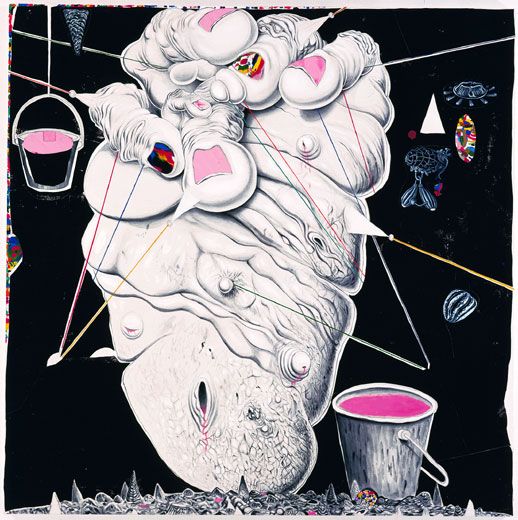Mounds vs. Vegans
In drawings and paintings, Trenton Doyle Hancock pits archetypes against each other
/https://tf-cmsv2-smithsonianmag-media.s3.amazonaws.com/filer/yi-hancock-631.jpg)
One of the youngest artists ever included in the Whitney Museum of American Art's Biennial exhibition (in both 2000 and 2002), Trenton Doyle Hancock, 33, incorporates comic-book and surreal themes into his satirical, intricately detailed drawings and paintings. In the ongoing epic story that sweeps through the Houston-based artist's vibrant works, “Mounds"—the good guys—face off against evil “Vegans."
How would you describe your work?
Naughty. Nice. Unpredictable. I make paintings, but the format into which I put the paintings encompasses drawing, sculpture and narration. So it has a large scope.
You've been compared to Hieronymus Bosch, Salvador Dali, the poet William Blake—do you count them among your influences?
I would definitely list those guys. I'm more interested in Max Ernst than Dali. [Ernst's] work seems genuinely stranger to me. I get a lot of inspiration, actually, from thrift-store paintings by people who don't know how to paint.
Your stepfather was a Baptist minister. How did that upbringing affect your art?
For a long time I didn't want anything to do with that past. I wanted to forget about it. Then I realized, whoa, there's so much beauty in that language, even though it's often a lot of doom and gloom. I think I thrive off the lingering repression from that, and I think that feeds my art. Why can't we as humans do these certain things? Where does morality actually end, and does it have a place in art? My art asks those questions. It plays out through the narratives and the characters and the wars that ensue.
Who are the Mounds?
The Mounds are my stand-in for the earth. They're part plant, part animal. Mounds are very passive. They just are.
And the Vegans?
They're the opposition to these Mound characters. Whereas Mounds get bigger and bigger, Vegans are obsessed with getting smaller and smaller. They see the Mounds as a threat to that purity, and they are always plotting to destroy Mound-kind.
Are the Vegans a stand-in for people who push their morality on others?
Exactly. Instead of using Christianity or any other institution or religion that can become dogmatic, I decided, why not take [veganism] to an absurd level.
So your work is allegorical.
I think sometimes my stories start to lean toward a moral, but in the end it's up to each viewer to choose which way to go. I don't like to point and say, “This is the right way."
Your career has been successful so far, especially considering that you're still young. What are you most proud of?
That I've set goals and reached them. Having my work in a gallery, having work in a museum setting.
Was it always your plan to be an artist?
I was that geeky kid who sat in the back of the class and just drew pictures. I didn't ever want to be a fireman or a doctor or anything else. I just wanted to be an artist.
A former editorial assistant at Smithsonian, Amy Crawford is a student at Columbia University's Graduate School of Journalism.

/https://tf-cmsv2-smithsonianmag-media.s3.amazonaws.com/accounts/headshot/amy.png)
/https://tf-cmsv2-smithsonianmag-media.s3.amazonaws.com/accounts/headshot/amy.png)